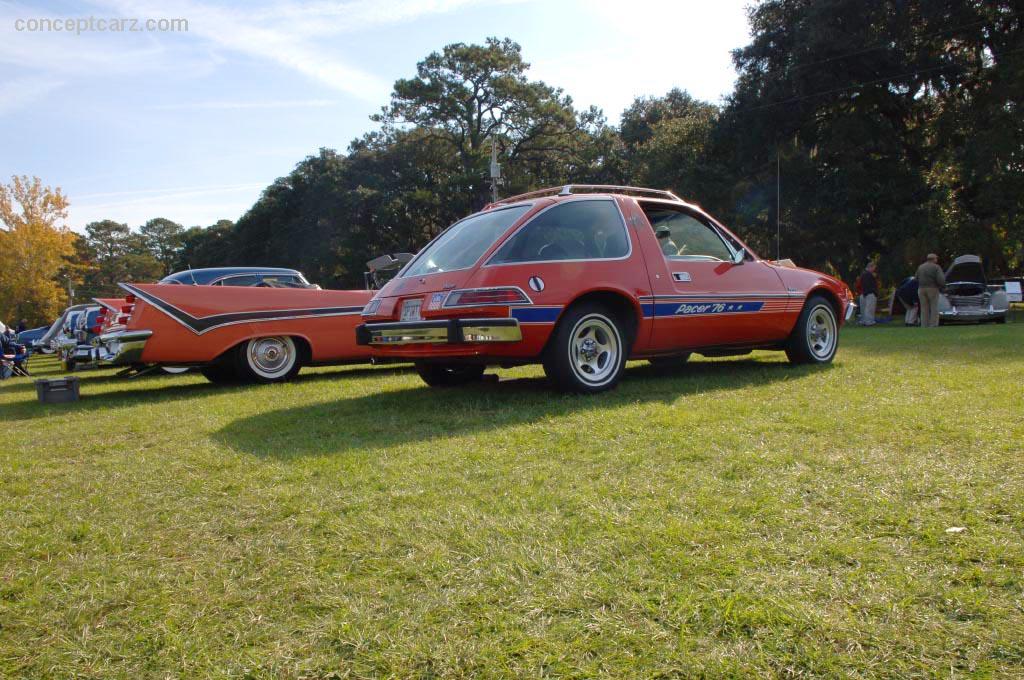1976 AMC Pacer Bi-Centennial Navigation



The AMC Pacer Bi-Centennial was from the legendary creator Richard A. Teaque, it was far out of the mainstream design of the 70's that AMC hoped it would create a nitch of its own. Unfortunately AMC pulled the plug on the rotary Wankle Motor. Production of 280,000 units was completed from 1975 to 1980.In 1977, a V-8 engine was introduced which gave the 'glass bubble' great acceleration. Note that the driver's door is four-inches shorter than the passenger door, making for an easy entry from the curbside.The Pacer was previously a one owner car. A little old lady in Pennsylvania owned the car since new, but could not drive it anymore. The car was never driven during the winter months. With about 75,000 miles on the car her son talked her into letting her grandson drive the car. For three months the car took quite a bit of abuse, so the dad sold the car to the current owner.
The car is completely original except the paint. The current owner says the car is a pure joy to drive.
The AMC Pacer was produced from 1975 through 1980. The design is one of the most recognizable of all time. Its large windows and fishbowl appearance were designed by Dick Teague with the purpose of appearing futuristic. Richard A. Teague, AMC's chief stylist, had begun working on the design in 1971. He designed the vehicle with the purpose of satisfying future safety regulations, fuel economy concerns, and small-car desires. The original Pacer design called for a roof bump that fell between the front and rear which would act as a roll bar. This never made it into production. Another design that never made it into production was the use of a Wankel rotary engine. Part of the demise of this feature was the rising fuel crisis and concerns about emission legislation in the United States. The Wankel engine did not comply with emission levels so in 1974 GM canceled its development.The vehicle rested on a 100-inch wheelbase and had a length of 171.8 inches. The large window was designed to break into small round beads in case of an accident. The glass was also designed to help retain passengers inside the vehicle even upon an accident or roll-over. The extensive use of glass made the car rather heavy, which ultimately hurt its fuel economy. In the city, the Pacer average 16 mpg and 26 MPG on the highway. The Pacer design was very aerodynamic, achieving a drag coefficient of .32.
During the first year of the AMC Pacer's introduction, there were 145,528 examples produced. Part of its success was its compact design and little competition from other manufacturers. Sales throughout the next few years fell sharply and by 1980, AMC was no longer producing the vehicle. In an effort to stimulate sales and to improve performance, AMC outfitted the Pacer with a High Output 258 cubic-inch six-cylinder engine in 1976. This did, however, decrease the fuel economy. In 1978 a 304 cubic-inch V8 could be added to the Pacer. In total, 280,000 examples of the AMC Pacer were built. The design is still considered controversial. Its wide body and short design was uncommon. Also, a small car being powered by large engines did little for its fuel economy or its appeal.The foresight by Teague and AMC was correct with the evolving emission controls, US regulations, and fuel crisis. Sadly, the compact design of the Pacer was controversial; had it been met with a greater appeal, the AMC Pacer made have had stronger sales.
By Daniel Vaughan | Dec 2006
The design of the AMC Pacer had been intended for the lightweight and compact Wankel engine. When the idea was abandoned, it left AMC struggling to find an alternative. The design was reconfigured to house the AMC inline six-cylinder engine.
By Daniel Vaughan | Dec 2006
- 1976 AMC Pacer Bi-Centennial Menu
- Article
- Image gallery
- Specifications
- Profiles
AMC
Similarly Sized Vehicles
from 1976
1976 AMC Pacer Bi-Centennial Vehicle Profiles
Recent Vehicle Additions
Performance and Specification Comparison
Pacer Specification Comparison by Year
Year
Production
Wheelbase
Engine
Prices
100.00 in.
6 cyl., 232.00 CID., 90.00hp
6 cyl., 258.00 CID., 95.00hp
8 cyl., 304.00 CID., 120.00hp
6 cyl., 258.00 CID., 95.00hp
8 cyl., 304.00 CID., 120.00hp
$3,500 - $3,500
Related Automotive News

DODGE ANNOUNCES PRICING FOR NEW 2014 DODGE DURANGO
Best-equipped Seven Passenger SUV Loaded With Advanced Technology, Efficiency, Performance and Style for a Starting U.S. MSRP Less Than %2430,000.
The new Dodge Durango features a slew of new standard features for 2014, including a new standard...

Audi At Le Mans: Active Safety In Focus
Digital rear-view mirror eliminates blind spot
LED headlights with matrix-beam principle define new standard
Additional functions on the steering wheel as a valuable strategic tool
Ingolstadt, June 6, 2013 – Two more weeks until the Le Man...

2013 RAM 1500 LARAMIE LONGHORN NAMED TO WARD'S 10 BEST INTERIORS LIST FOR 2013
For 2013, the Ram 1500s award-winning interior includes material upgrades, all-new interior themes with invigorating colors that speak to the lifestyle of the Ram Truck brand
All-new HVAC controls and new multimedia systems enhance the drive...
GARMIN TO PROVIDE IN-DASH NAVIGATION FOR FUTURE MERCEDES-BENZ MODELS
Garmin® International Inc., a unit of Garmin Ltd. (NASDAQ GRMN), the global leader in satellite navigation, today announced that Daimler AG has selected Garmin as global navigation provider for future Mercedes-Benz models. Garmins award-winning navigation...

1991 24 Hours of Le Mans: Facing the Giants
It had been more than thirty years but the Silver Arrows would compete, and win, the 24 Hours of Le Mans. Jaguar would also earn its first victory in more than thirty years when it took the overall honors in 1988. And then there was Porsche, the most...













